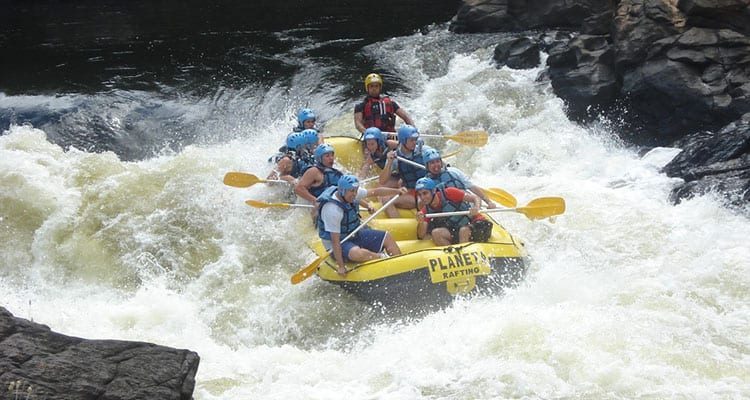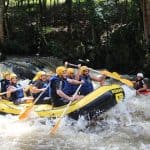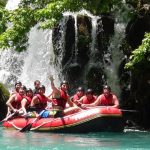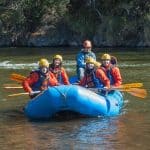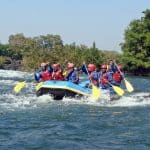Rafting and white water rafting are recreational outdoor activities which use an inflatable raft to navigate a river or other body of water. This is often done on whitewater or different degrees of rough water, and generally represents a new and challenging environment for participants. Dealing with risk and the need for teamwork is often a part of the experience. The development of this activity as a leisure sport has become popular since the mid-1970s, evolving from individuals paddling 10 feet (3.0 m) rafts with double-bladed paddles to multi-person rafts propelled by single-bladed paddles and steered by a tour guide at the stern. It is considered an extreme sport, and can be fatal. The International Rafting Federation (IRF) is the worldwide body which oversees all aspects of the sport.
Techniques
Rafts in white water are very different vehicles than canoes or kayaks and have their own specific techniques to maneuver through whitewater obstacles. Examples of these techniques include.
Punching – Rafts carry great momentum, and on rivers hydraulics that are dodged by canoes and kayaks are often punched by rafts. This involves the rafting crew paddling the raft to give it enough speed to push through the hydraulic without getting stopped.
High siding – If a raft is caught in a hydraulic it will often quickly go sideways. In order to stop the raft flipping on its inside edge, the rafters can climb to the side of the raft furthest downstream, which will also be the side of the raft highest in the air leading to its name. In this position the rafters may be able to use the draw stroke to pull the raft out of the head.
Low siding- more of a professional maneuver sometimes used at LOW water to slide through a channel less than the size of your craft.
Capsizing[edit]
Dump truck – Rafts are inherently stable craft because of their size and low center of mass, and often they will shed gear and passengers before they actually capsize. In the industry, if a raft dumps some or all of its passengers but remains upright, it is said to have dump-trucked.
Left over right or right over left – Rafts almost always flip side over side. If the left tube rises over the right tube, the raft is said to have flipped left over right and vice versa.
Taco – If a raft is soft, or under-inflated, it may taco, or reverse taco. Rafts are said to have tacoed if the middle of the raft buckles and the front of the raft touches or nearly touches the back of the raft. This is often a result of surfing in a hydraulic. A reverse taco is when the nose or stern of the raft is pulled down under water and buckles to touch the middle, back or nose of the raft.
End over end – Occasionally rafts will flip end over end. This is usually after the raft has dump-trucked to lighten the load, allowing the water to overcome the weight of the boat, flipping it vertically before it lands upside down. Rafts will more often taco and turn sideways, making an end-over-end flip very rare in most rafts.
Downstream flip – A raft capsizes after encountering an obstacle, such as a rock, a feature like a hydraulic, or even another raft. These objects are usually stationary or possibly surfing in a hydraulic. In this event, the raft becomes unstable and usually flips over downstream or in the direction of travel. A downstream flip may be exacerbated by a heavier load or more people in the raft. People may physically assist in the inertia of the flip by pulling the boat over on top of themselves.
Back roller – A broad reversal such as that formed below a dam or ledge. Rafts can be particularly vulnerable to back rollers, because they can quickly fill a raft and then push it down at the back. If there are snags at the bottom of the river, dumped rafters can be caught and drowned in the aerated and therefore less buoyant water.
Dark-siding – A rafter climbing over a side tube as the raft flips. In swim beer rules, anyone who witnesses one of these owes beer to the “successful dark-sider”. He or she may be responsible for any beer owed for the ensuing clean-up, depending on the region.
White water rafting can be a dangerous sport, especially if basic safety precautions are not observed. That said, fatalities are rare in both commercial and private rafting. Meta-analyses have calculated fatalities fell between 0.55 – 0.86% per 100,000 user days. Studies have shown that injury rates in rafting are relatively low, however may be skewed due to a large number of unreported incidents. Typical rafting injuries include trauma from striking an object, traumatic stress from the interaction of the paddler’s positioning and equipment and the force of the water, overuse injuries, and submersion/environmental injuries, non environmental, undisclosed medical conditions (such as heart problems).
Depending on the area, safety regulations covering raft operators may exist in legislation. These range from certification of outfitters, rafts, and raft leaders, to more stringent regulations about equipment and procedures. It is generally advisable to discuss safety measures with a rafting operator before signing on for a trip. The equipment used and the qualifications of the company and raft guides are essential information to be considered.
Like most outdoor sports, rafting in general has become safer over the years. Expertise in the sport has increased, and equipment has become more specialized and improved in quality. As a result, the difficulty rating of most river runs has changed. A classic example would be the Colorado River in the Grand Canyon, which has swallowed whole expeditions in the past, leaving only fragments of boats. In contrast, it is now run safely by commercial outfitters hundreds of times each year with relatively untrained passengers.
Risks in white water rafting stem from both environmental dangers and from improper behavior. Certain features on rivers are inherently unsafe and have remained consistently so despite the passage of time. These would include ‘keeper hydraulics’, ‘strainers’ (e.g. fallen trees), dams (especially low-head dams, which tend to produce river-wide keeper hydraulics), undercut rocks, and of course dangerously high waterfalls. Rafting with experienced guides is the safest way to avoid such features. Even in safe areas, however, moving water can always present risks—such as when a swimmer attempts to stand up on a rocky riverbed in strong current, risking foot entrapment. Irresponsible behavior related to rafting while intoxicated has also contributed to many accidents.
To combat the illusion that rafting is akin to an amusement park ride, and to underscore the personal responsibility each rafter faces on a trip, rafting outfitters generally require customers to sign waiver forms indicating understanding and acceptance of potential serious risks. Rafting trips often begin with safety presentations to educate customers about problems that may arise.
White water rafting is often played for the adrenaline rush and this can become a problem for participants’ safety. White water rafting accidents have occurred but are not common.
Due to this the overall risk level on a rafting trip with experienced guides using proper precautions is low. Thousands of people safely enjoy raft trips every year.
